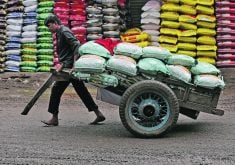Department argued that the goal was to get industry to take a bigger role in science and innovation projects
Agriculture Canada bureaucrats hit upon a benign-sounding catch phrase as they devised strategies on how to explain and sell sharp re-search branch cuts in the March 21 federal budget.
The government was merely “right-sizing” the federal presence in agricultural research to reduce the government’s “footprint” and increase industry responsibility.
“This allows (Agriculture Canada) to further right-size the science and technology branch in support of science that aligns with departmental, governmental and sector priorities and the appropriate role for government in science innovation,” said a document called “speaking points” prepared for deputy agriculture minister Suzanne Vinet days before the budget was unveiled.
Read Also

Agritechnica Day 3: Hybrid drive for a combine, data standards keep up to tech change and tractors of the year
Agritechnica 2025 Day 3: Hybrid drive for a combine, data standards keep up to tech change and tractors of the year.
“The mid to long-term goal is to help position the industry to play a more active role in science and innovation activities.”
For many public servants, particularly in Western Canada, right sizing meant downsizing.
At least 230 science and technology branch positions have been or will be lost, and research sites or programs will be cut across the country, including more than a dozen in the West.
“The majority of discontinuation, consolidation and right-sizing activities are located in Western Canada, where the majority of government and industry science capacity is currently located,” said the memo to Vinet.
The federal government was also bracing for negative reaction, according to internal Agriculture Canada analyses and briefing notes for discussions with provincial agriculture ministers that Ottawa researcher Ken Rubin obtained under access to information rules.
“Reductions in science capacity will be viewed negatively by the sector and the unions,” the deputy minister was warned.
“Industry and academia opposition will be mixed, depending on their capacity to assume the work. Beef, forage, dairy and greenhouse industries are expected to lobby against these decisions.”
As well, federal and provincial politicians and media were expected to be negative.
“Expect to see tables of cumulative (Agriculture Canada) cutbacks and editorials challenging the government of Canada’s commitment to the industry.”
In fact the government faced little sustained public pressure over the research cuts as agriculture minister Gerry Ritz continued to insist support for science and research had never been stronger.
The departmental briefing notes said the changes were the result of the implementation of Growing Forward 2 April 1.
Many critics argued that the cuts to business risk management programs, staff, government programs and offices were a way to cut spending as Agriculture Canada’s contribution to government deficit reduction.
However, all references to the financial savings that would result were blacked out before the documents were released.
In the talking points drafted for the deputy minister, the department said it wasn’t a new tactic to sell the cuts as a way to strengthen the department’s spending effectiveness by making “focused investments” in areas where the government has a mandate while opening room for industry to contribute.
“This approach is consistent with earlier methods of reduction, in which we minimized the visibility of restraint exercises,” said the document.
“There is a risk of maintaining expectations because the science and technology branch will be seen to have capacity but may lack critical mass, flexibility and sufficient operating funds to be responsive to opportunities and challenges in a timely manner.”
The list of cuts and programs affected is extensive. A partial list includes:
- Ending beef production research east of Saskatchewan and expecting universities and provinces to fill the gap.
- Cutting dairy research in Agassiz, B.C., Truro, N.S., and Guelph, Ont.
- Closing research offices in Kam-loops, B.C., One Four, B.C., and Staveley, Alta., with the work consolidated in Swift Current, Sask.
- Closing former Alberta Prairie Farm Rehabilitation Administration offices in Westlock, Peace River and Red Deer as well as Saskatchewan offices in Melville, Watrous, North Battleford and Weyburn.
- Ending pea breeding in Lacombe, Alta., and expecting the pea program at the University of Saskatchewan to pick up the slack.
- Ending most agro-environmental research.
- Cutting funding for a network of agricultural economics researchers across the country.
However, programs for some sensitive sectors were spared the cuts — hogs and grain.
“Changes to science support would be difficult given the current market environment for the hog sector,” said the briefing notes.
“(It is important to continue science and technology branch science support during (the) current transition period for grains and oilseeds.”














